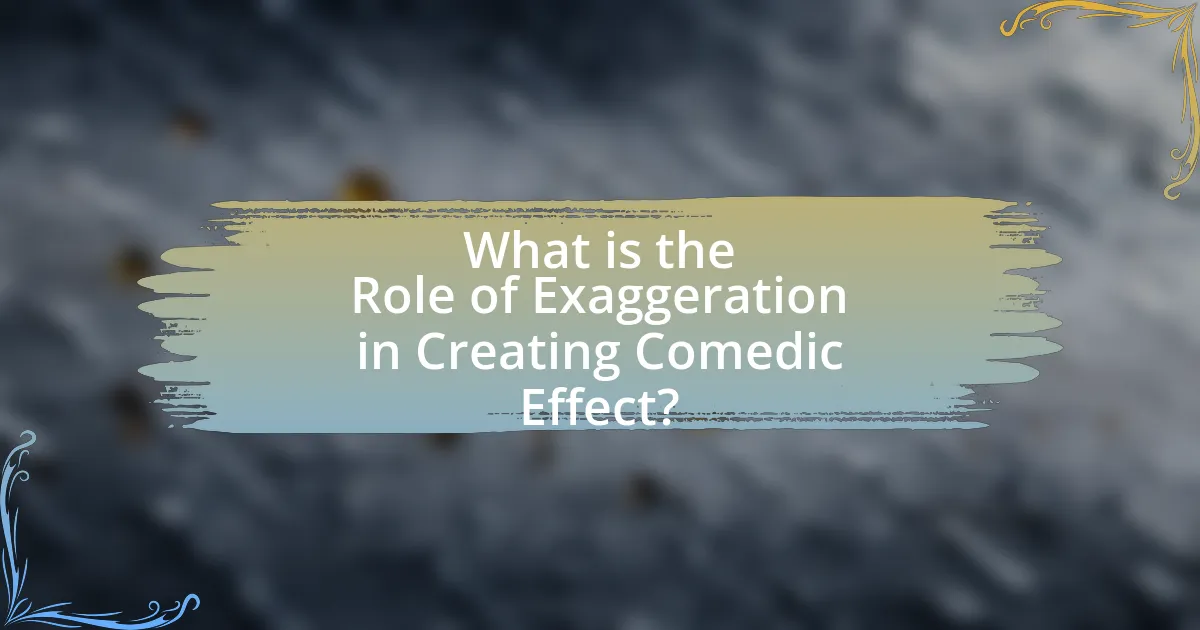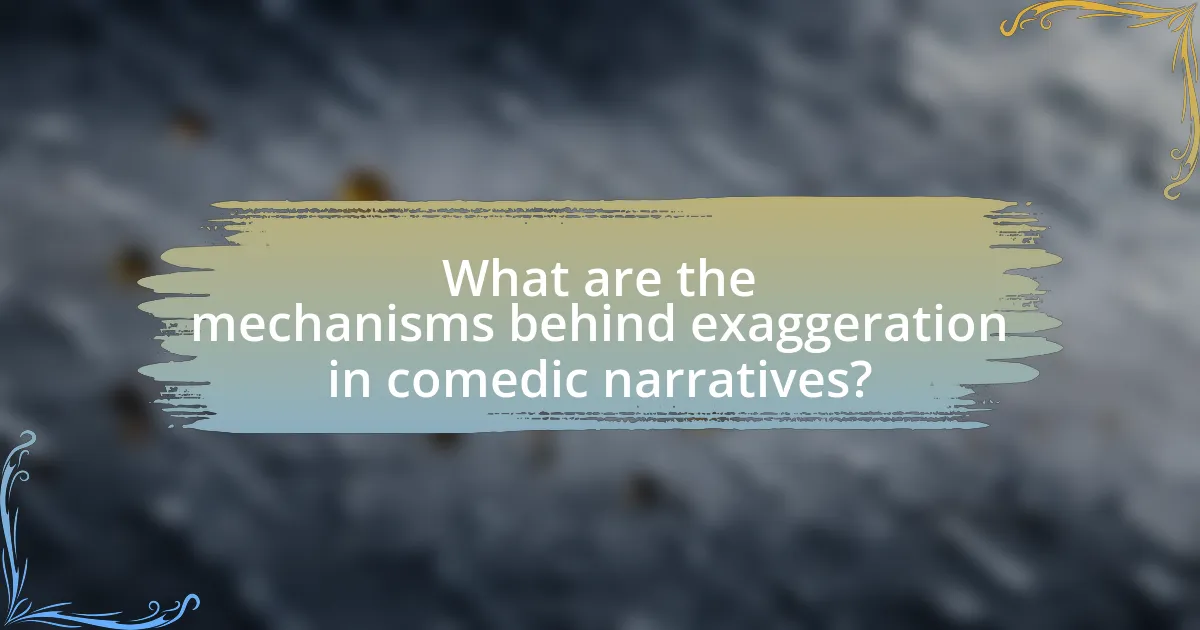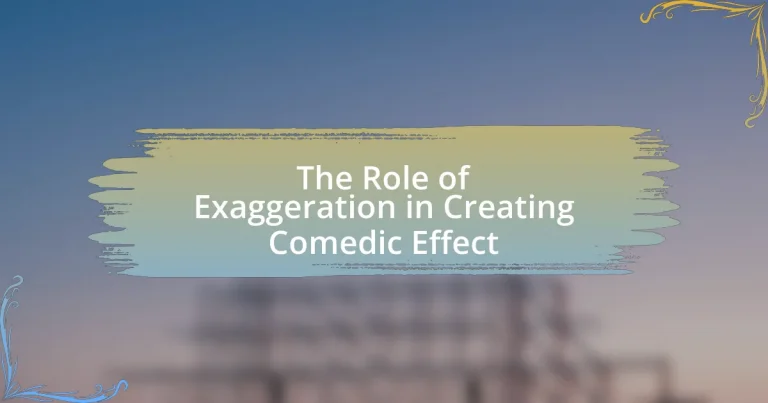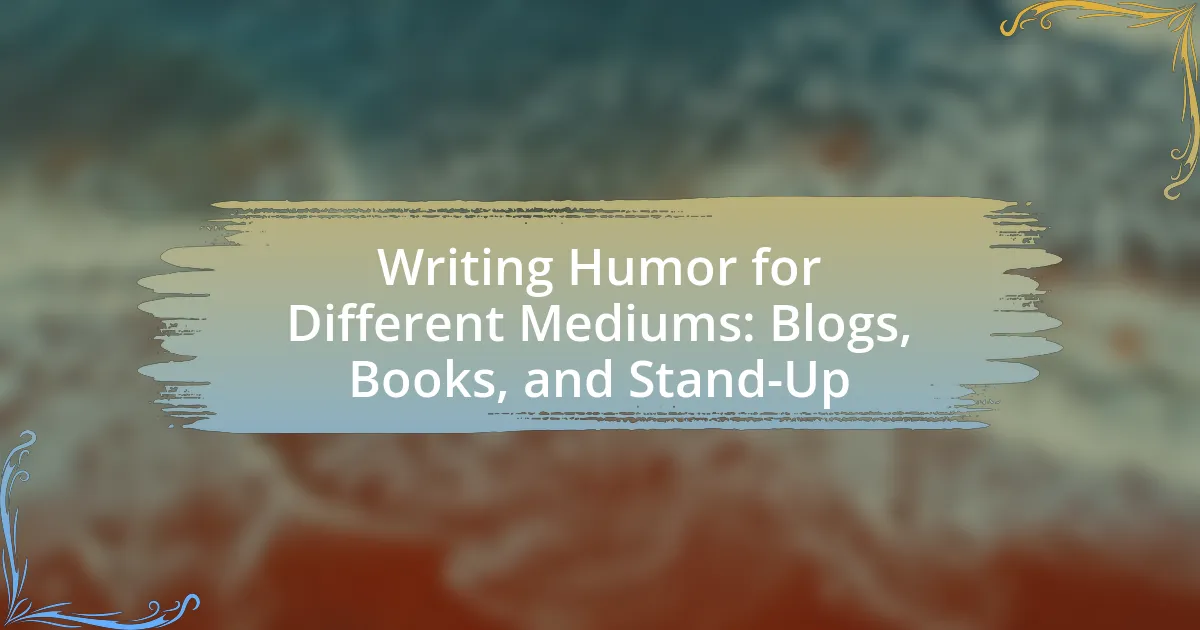The article examines the role of exaggeration in creating comedic effect, highlighting its significance in amplifying characteristics and situations to absurd levels. It discusses various forms of exaggeration, including hyperbole, caricature, and absurdity, and how these techniques contribute to humor by emphasizing incongruities in everyday life. The article also explores the psychological effects of exaggeration on audiences, the influence of cultural context, and the mechanisms behind exaggeration in comedic narratives. Additionally, it addresses the balance between exaggeration and authenticity in comedic performances, providing insights into how comedians can effectively utilize exaggeration to enhance their storytelling and engage audiences.

What is the Role of Exaggeration in Creating Comedic Effect?
Exaggeration plays a crucial role in creating comedic effect by amplifying characteristics or situations to an absurd level, making them humorous. This technique allows comedians to highlight the ridiculousness of everyday life, drawing attention to flaws or quirks in human behavior. For instance, the use of hyperbole can transform a mundane scenario into a laughable one, as seen in stand-up routines where a simple annoyance is exaggerated to an extreme, eliciting laughter through relatability and surprise. Research indicates that humor often arises from incongruity, where the unexpected nature of exaggerated elements creates a cognitive shift that results in amusement.
How does exaggeration contribute to humor?
Exaggeration contributes to humor by amplifying characteristics or situations to an absurd level, making them more relatable and entertaining. This technique highlights the incongruities in everyday life, allowing audiences to recognize the ridiculousness of a scenario. For example, comedians often use hyperbole to emphasize emotions or reactions, such as claiming they are “so hungry they could eat a horse,” which creates a vivid mental image that elicits laughter. Research in psychology indicates that humor often arises from the violation of expectations, and exaggeration effectively disrupts normal perceptions, leading to comedic outcomes.
What are the different forms of exaggeration in comedy?
Different forms of exaggeration in comedy include hyperbole, caricature, and absurdity. Hyperbole involves extreme overstatements to create humor, such as saying “I’m so hungry I could eat a horse.” Caricature exaggerates specific traits of characters or situations, often highlighting flaws or quirks for comedic effect, like portraying a politician with an oversized head to emphasize their ego. Absurdity presents illogical or nonsensical scenarios that defy reality, such as a talking dog solving crimes, which generates laughter through its sheer ridiculousness. These forms of exaggeration effectively enhance comedic impact by amplifying relatable experiences or characteristics to an extreme degree.
How does exaggeration enhance comedic timing?
Exaggeration enhances comedic timing by amplifying the absurdity of a situation, making the punchline more impactful. When a comedian exaggerates a scenario or characteristic, it creates a heightened sense of expectation and surprise, which are crucial elements of effective timing. For instance, a comedian might describe a mundane event, like waiting in line, with extreme hyperbole, transforming it into a relatable yet ridiculous experience. This technique not only captures the audience’s attention but also sets up a rhythm that leads to a more effective delivery of the punchline, as the contrast between the exaggeration and reality elicits laughter. Studies in humor psychology indicate that incongruity, often achieved through exaggeration, is a key factor in humor appreciation, reinforcing the idea that exaggeration is essential for enhancing comedic timing.
Why is exaggeration a common technique in comedy?
Exaggeration is a common technique in comedy because it amplifies characteristics or situations to an absurd level, making them humorous. This technique effectively highlights the ridiculousness of everyday life, allowing audiences to recognize and laugh at the exaggeration of familiar experiences. For instance, comedians often use hyperbole to emphasize flaws or quirks in human behavior, which resonates with audiences and creates a shared understanding of the humor in those exaggerations. Studies in humor psychology indicate that exaggeration can enhance comedic impact by creating surprise and incongruity, key elements that elicit laughter.
What psychological effects does exaggeration have on audiences?
Exaggeration has significant psychological effects on audiences, primarily by enhancing emotional engagement and facilitating humor. When presented with exaggerated scenarios or characters, audiences experience heightened emotional responses, as the absurdity of the exaggeration often elicits laughter or surprise. Research indicates that humor derived from exaggeration activates the brain’s reward system, particularly the ventral striatum, which is associated with pleasure and motivation. This activation reinforces positive feelings and can lead to increased social bonding among audience members, as shared laughter fosters a sense of community. Additionally, exaggeration can serve as a cognitive tool, allowing audiences to process complex ideas or social critiques in a more digestible and entertaining manner, thereby enhancing understanding and retention of the underlying message.
How does cultural context influence the use of exaggeration in comedy?
Cultural context significantly influences the use of exaggeration in comedy by shaping the norms, values, and references that comedians draw upon. Different cultures have unique sensitivities and humor styles, which dictate what is considered acceptable or funny. For instance, in cultures that value directness, exaggeration may be used to highlight absurdities in everyday life, while in cultures that prioritize subtlety, exaggeration might serve to critique social norms indirectly. Research indicates that humor often relies on shared cultural knowledge; therefore, comedians must tailor their exaggerations to resonate with their audience’s cultural background, ensuring that the comedic effect is both relatable and impactful.

What are the mechanisms behind exaggeration in comedic narratives?
Exaggeration in comedic narratives primarily operates through hyperbole, absurdity, and incongruity. Hyperbole amplifies characteristics or situations to an extreme degree, making them humorous by their sheer improbability; for example, a character claiming to have run a mile in seconds highlights the absurdity of the claim. Absurdity involves presenting situations that defy logic or reason, creating humor through unexpected outcomes, such as a talking animal in a serious context. Incongruity arises when there is a mismatch between expectations and reality, leading to surprise and laughter; for instance, a serious character reacting comically to trivial events emphasizes this contrast. These mechanisms are supported by psychological theories of humor, such as the Incongruity Theory, which posits that humor arises from the perception of incongruity between what is expected and what occurs.
How do comedians utilize exaggeration in storytelling?
Comedians utilize exaggeration in storytelling to amplify humor and engage audiences effectively. By stretching the truth or amplifying characteristics, comedians create absurd scenarios that highlight the ridiculousness of everyday situations. For instance, a comedian might describe a minor inconvenience, like losing keys, as a catastrophic event, thereby eliciting laughter through relatability and hyperbole. This technique not only enhances comedic timing but also allows for a deeper connection with the audience, as they recognize the exaggerated elements from their own experiences.
What role does character exaggeration play in comedic narratives?
Character exaggeration serves as a crucial mechanism in comedic narratives by amplifying traits and behaviors to create humor. This amplification allows audiences to recognize absurdities in characters’ actions or personalities, leading to comedic situations that highlight the contrast between reality and the exaggerated portrayal. For instance, in classic sitcoms, characters often embody extreme stereotypes—such as the overly frugal person or the perpetually clumsy individual—making their interactions and conflicts inherently funny. Research indicates that exaggeration can enhance comedic timing and delivery, as seen in studies on humor perception, which show that heightened traits elicit stronger emotional responses from audiences, thereby reinforcing the comedic effect.
How does situational exaggeration create comedic scenarios?
Situational exaggeration creates comedic scenarios by amplifying ordinary circumstances to absurd levels, which elicits laughter through surprise and incongruity. This technique relies on the audience’s recognition of the exaggerated elements as unrealistic, contrasting sharply with their expectations of normalcy. For example, in comedic films, a character might react to a minor inconvenience, like spilling coffee, as if it were a catastrophic event, heightening the humor through the disparity between the situation and the reaction. Research in humor theory, such as the Incongruity Theory, supports this by suggesting that humor arises when there is a mismatch between what is expected and what actually occurs, making situational exaggeration a key tool in crafting effective comedic narratives.
What are the limits of exaggeration in comedy?
The limits of exaggeration in comedy are defined by audience perception and cultural context. Exaggeration can enhance humor by amplifying traits or situations, but it risks alienating audiences if it becomes too unrealistic or offensive. For instance, comedic styles vary widely; slapstick may tolerate higher levels of exaggeration compared to satire, which often requires a balance to maintain credibility. Research indicates that humor is most effective when it resonates with shared experiences, suggesting that excessive exaggeration can undermine relatability and effectiveness.
How can excessive exaggeration detract from humor?
Excessive exaggeration can detract from humor by making the comedic elements feel unrealistic and less relatable. When humor relies too heavily on exaggeration, it risks alienating the audience, as they may struggle to connect with the absurdity presented. Research indicates that humor often thrives on a balance between the familiar and the exaggerated; for instance, a study published in the journal “Humor: International Journal of Humor Research” by authors such as Robert Provine highlights that effective humor typically involves a degree of realism that allows audiences to engage with the content. Therefore, when exaggeration crosses a threshold, it can undermine the comedic effect by distancing the audience from the humor.
What are the risks of misusing exaggeration in comedic contexts?
Misusing exaggeration in comedic contexts can lead to misunderstandings and alienation of audiences. When exaggeration is taken too far, it may distort the intended message, causing confusion about the joke’s purpose or meaning. Additionally, excessive exaggeration can reinforce negative stereotypes or perpetuate harmful narratives, which may offend certain groups. Research indicates that humor that relies on exaggeration can backfire if it alienates the audience or fails to resonate with their experiences, leading to a loss of connection and engagement.

How does exaggeration vary across different comedic styles?
Exaggeration varies significantly across different comedic styles, influencing the delivery and reception of humor. In slapstick comedy, for instance, physical exaggeration is paramount, with characters often experiencing extreme situations, such as exaggerated falls or absurdly large props, to elicit laughter. In contrast, stand-up comedy frequently employs verbal exaggeration, where comedians amplify personal anecdotes or societal observations to highlight absurdities, as seen in the works of comedians like George Carlin or Chris Rock.
Moreover, in satire, exaggeration serves to critique societal norms or political issues, often through hyperbole that emphasizes the ridiculousness of the subject matter, as exemplified by shows like “Saturday Night Live.” Each comedic style utilizes exaggeration differently, tailoring it to fit the medium and audience expectations, thereby enhancing the comedic effect.
What are the differences in exaggeration between stand-up and sketch comedy?
Stand-up comedy typically employs exaggeration to amplify personal anecdotes and observations, creating a relatable yet heightened comedic effect. In contrast, sketch comedy utilizes exaggeration to develop characters and scenarios that are often absurd or surreal, allowing for a broader range of comedic situations. For instance, stand-up comedians like George Carlin often exaggerate real-life experiences to highlight societal absurdities, while sketch shows like “Saturday Night Live” create exaggerated caricatures of public figures to satirize current events. This distinction illustrates how stand-up focuses on individual perspective through hyperbole, whereas sketch comedy leverages collective absurdity through character-driven exaggeration.
How does exaggeration manifest in physical comedy versus verbal comedy?
Exaggeration in physical comedy manifests through exaggerated movements, facial expressions, and physical interactions that amplify humor, while in verbal comedy, it appears through hyperbolic language, absurd scenarios, and exaggerated character traits. In physical comedy, performers like Charlie Chaplin or Buster Keaton utilize exaggerated gestures and slapstick elements to create humor, as seen in Chaplin’s iconic pratfalls that emphasize the absurdity of situations. In contrast, verbal comedy employs exaggeration through witty dialogue and over-the-top storytelling, as demonstrated by comedians like George Carlin, who often used hyperbole to critique societal norms. This distinction highlights how both forms of comedy leverage exaggeration to elicit laughter, albeit through different mediums.
What role does exaggeration play in satire and parody?
Exaggeration serves as a fundamental mechanism in both satire and parody, amplifying characteristics or behaviors to highlight flaws or absurdities. In satire, exaggeration critiques societal norms or political issues by presenting them in an exaggerated manner, making the underlying message more impactful and thought-provoking. For instance, Jonathan Swift’s “A Modest Proposal” uses hyperbolic suggestions to criticize British policy towards the Irish, effectively drawing attention to the severity of the situation. In parody, exaggeration mimics the style or content of the original work, often to humorous effect, by distorting its elements to reveal its shortcomings. An example is “Scary Movie,” which exaggerates horror film tropes to both entertain and critique the genre. Thus, exaggeration is essential in both forms, as it enhances comedic effect while delivering critical commentary.
How can understanding exaggeration improve comedic writing?
Understanding exaggeration enhances comedic writing by allowing writers to amplify humor through absurdity and hyperbole. This technique creates a stark contrast between reality and the exaggerated scenario, which can elicit laughter by surprising the audience. For instance, comedians often use exaggerated character traits or situations to highlight flaws or absurdities in everyday life, making the humor relatable yet larger-than-life. Research indicates that exaggeration can trigger a stronger emotional response, as it engages the audience’s imagination and encourages them to see familiar situations in a new light. This approach not only entertains but also deepens the comedic impact by making the humor more memorable and engaging.
What techniques can writers use to effectively incorporate exaggeration?
Writers can effectively incorporate exaggeration through techniques such as hyperbole, absurdity, and caricature. Hyperbole involves making exaggerated claims that are not meant to be taken literally, which can enhance humor by highlighting the ridiculousness of a situation. Absurdity pushes scenarios to illogical extremes, creating a comedic effect by presenting situations that defy common sense. Caricature exaggerates specific traits of characters or situations, emphasizing their most ridiculous aspects to provoke laughter. These techniques are widely used in comedic literature and performances, as they amplify the humor and engage the audience by presenting familiar concepts in an exaggerated manner.
How can comedians balance exaggeration with authenticity in their performances?
Comedians can balance exaggeration with authenticity by grounding their exaggerated narratives in relatable experiences. This approach allows them to amplify humor while maintaining a connection with the audience. For instance, comedians often draw from personal anecdotes that resonate with common human experiences, which enhances the authenticity of their exaggerated portrayals. Research indicates that humor is more effective when it reflects shared realities, as seen in studies by the University of California, which found that audiences respond positively to humor that combines personal truth with hyperbole. This balance fosters a comedic effect that feels both entertaining and genuine.





